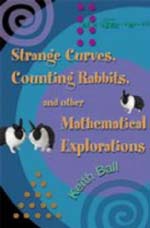'Strange curves, counting rabbits'

Strange curves, counting rabbits, and other mathematical explorations
By Keith Ball
Are you interested in maths just for the fun of it? Or does mathematics seem irrelevant? Either way, this book is for you. Keith Ball is eager to share with his readers the way some of the numbers around us in the world work, and their uses.
He starts by explaining how a code can send information from Mars to Earth (for example), and then fix any mistakes in itself before it is decoded. You can even work out how accurate this code would be. Then he proves Pick's theorem (which gives the area of a simple polygon on a lattice by counting lattice points) in a perfectly clear and understandable way.
The book continues in this manner, with famous and less-famous theorems explained and proven, accompanied by unusual applications, particularly of concepts from pure mathematics. Probability is used to explain just how few people you need in a room before there is a 50% chance two of them will have the same birthday, then this is elaborated to more complex situations. The Fibonacci sequence and variations are explored, and you can even learn how to fill in a non-zero area with a curve that has zero width.
To follow this book it is essential that you are comfortable with algebra. A couple of the chapters are also easier to follow if you know some calculus. However, mostly Ball does not rely on the reader having any prior knowledge beyond algebra, and he explains some of those little things that rarely get explained properly in classes and lectures.
You get a chance to explore the ideas the author describes with the practice examples smattered throughout the text, and full answers are given at the end of each chapter in case you get stuck. And should you be keen for more, each chapter also has a "Further Reading" section with descriptions of the books mentioned.
I would recommend this book to able students in their last year of secondary school or recently started at university, who will be fascinated by how seemingly unrelated concepts tie together, and where they come from.
- Book details:
- Strange curves, counting rabbits, and other mathematical explorations
- Keith Ball
- hardback - 296 pages (2003)
- Princeton University Press
- ISBN: 0691113211